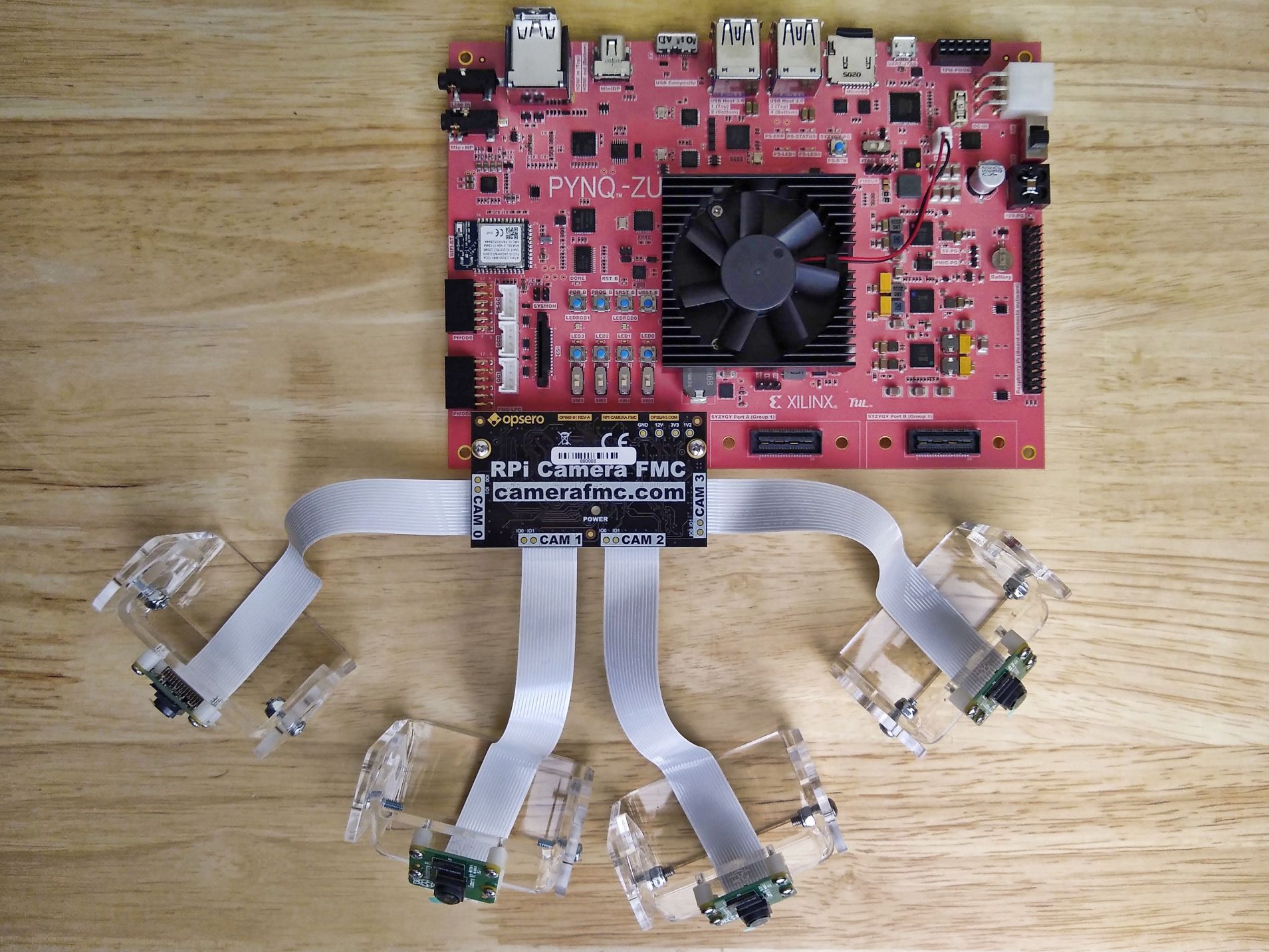This project demonstrates the Opsero RPi Camera FMC (OP068) used to connect 4x Raspberry Pi cameras (or compatible cameras) to one of the target FPGA/MPSoC boards listed below. The designs contain:
- 4x MIPI CSI capture pipelines
- Video Mixer IP based display pipeline to DisplayPort output
- Video Codec Unit (VCU)
The high level block diagram below illustrates the design:

The video pipe sub-blocks are illustrated below:

Important links:
- The RPi Camera FMC datasheet
- The user guide for these reference designs
- To report an issue
- For technical support: Contact Opsero
This project is designed for version 2024.1 of the Xilinx tools (Vivado/Vitis/PetaLinux). If you are using an older version of the Xilinx tools, then refer to the release tags to find the version of this repository that matches your version of the tools.
In order to test this design on hardware, you will need the following:
- Vivado 2024.1
- Vitis 2024.1
- PetaLinux Tools 2024.1
- Linux PC for build
- One or more Raspberry Pi Camera Module 2 and/or Digilent Pcam 5C cameras
- 1x RPi Camera FMC
- 1x DisplayPort monitor that supports 1080p video
- One of the supported target boards listed below
| Target board | Target design | FMC Slot | Cameras | VCU | Vivado Edition |
|---|---|---|---|---|---|
| ZCU104 | zcu104 |
LPC | 4 | ✅ | Standard 🆓 |
| ZCU102 | zcu102_hpc0 |
HPC0 | 4 | ❌ | Standard 🆓 |
| ZCU102 | zcu102_hpc1 |
HPC1 | 2 | ❌ | Standard 🆓 |
| ZCU106 | zcu106_hpc0 |
HPC0 | 4 | ✅ | Standard 🆓 |
| PYNQ-ZU | pynqzu |
LPC | 2 | ❌ | Standard 🆓 |
| UltraZed-EV Carrier | uzev |
HPC | 4 | ✅ | Standard 🆓 |
Notes:
- The Vivado Edition column indicates which designs are supported by the Vivado Standard Edition, the FREE edition which can be used without a license. Vivado Enterprise Edition requires a license however a 30-day evaluation license is available from the AMD Xilinx Licensing site.
- The HPC1 connector of the ZCU102 board can only support 2 cameras due to it's pin assignment. This design
supports the
CAM0andCAM1slots as labelled on the RPi Camera FMC. - The
pynqzutarget design has video pipelines for only 2 cameras:CAM1andCAM2as labelled on the RPi Camera FMC. This is due to the resource limitations of the devices on this board.
These reference designs can be driven within a PetaLinux environment. The repository includes all necessary scripts and code to build the PetaLinux environment. The table below outlines the corresponding applications available:
| Environment | Available Applications |
|---|---|
| PetaLinux | Built-in Linux commands Additional tools: GStreamer |
This repo contains submodules. To clone this repo, run:
git clone --recursive https://github.com/fpgadeveloper/rpi-camera-fmc.git
Source Vivado and PetaLinux tools:
source <path-to-petalinux>/2024.1/settings.sh
source <path-to-vivado>/2024.1/settings64.sh
Build all (Vivado project, accelerator kernel and PetaLinux):
cd rpi-camera-fmc/PetaLinux
make petalinux TARGET=uzev
From the PetaLinux command line, run the following command to stream video from all connected cameras to the 4 quadrants of the 1080p DisplayPort monitor:
sudo displaycams.sh
If less than 4 cameras are physically connected, the unused quadrants of the monitor will be blue.
We strongly encourage community contribution to these projects. Please make a pull request if you would like to share your work:
- if you've spotted and fixed any issues
- if you've added designs for other target platforms
- if you've added software support for other cameras
Thank you to everyone who supports us!
- Develop PYNQ support
- Add a standalone application
- Add support for some Versal boards
- Add VCU example scripts
- Get a Genesys-ZU board and test the design on hardware.
- Software support for more cameras (this will be an ongoing task due to the number of cameras available).
Opsero Inc. is a team of FPGA developers delivering FPGA products and design services to start-ups and tech companies. Follow our blog, FPGA Developer, for news, tutorials and updates on the awesome projects we work on.
